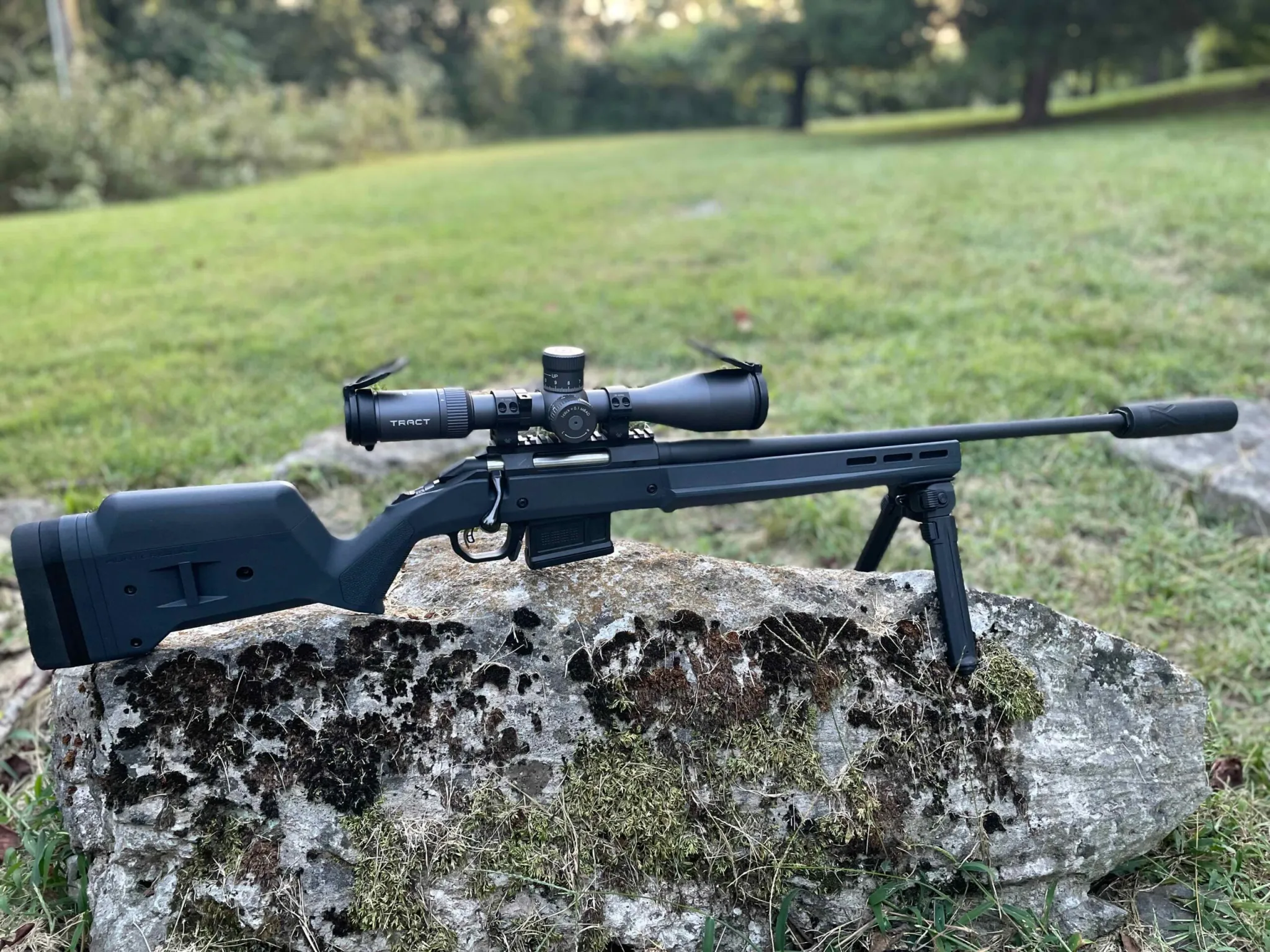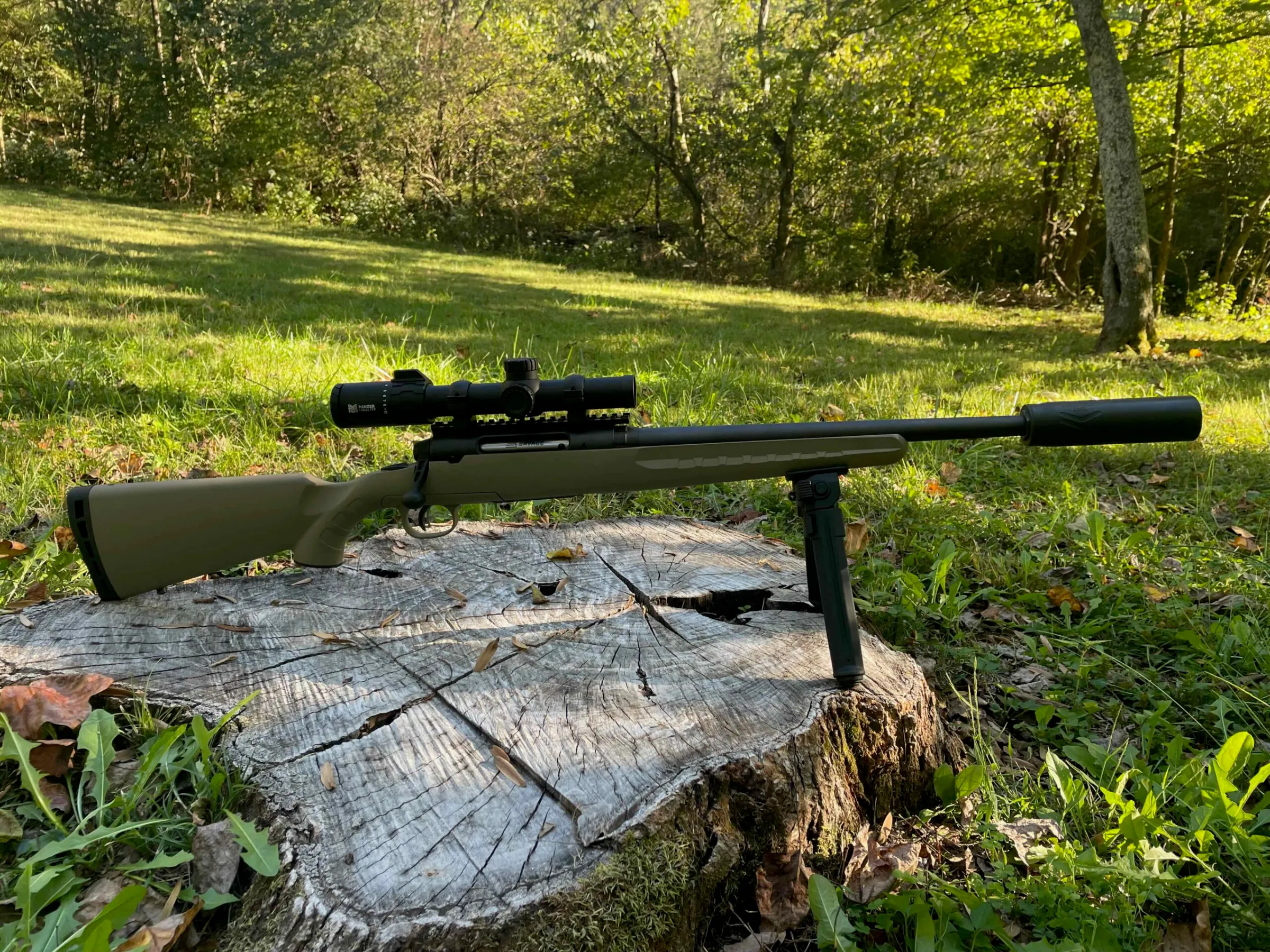When mounting a suppressor on a rifle, many shooters are surprised to discover their previously perfect zero is suddenly off. This shift in point of impact (POI) is a common and well-documented phenomenon that occurs with virtually all suppressed weapons systems. Understanding why this happens and how to address it is crucial for maintaining accuracy, whether you’re competing, hunting, or training
The Physics Behind POI Shift
At its core, a POI shift occurs because adding a suppressor fundamentally changes how your firearm behaves during the firing sequence. When you attach a suppressor, you’re adding mass to the muzzle end of your barrel, which alters its harmonics and vibration patterns. As a barrel fires, it doesn’t remain perfectly straight – it actually flexes and whips in a consistent pattern. This oscillation, known as barrel harmonics, affects where the bullet exits the bore in relation to the barrel’s neutral axis. A suppressor’s additional weight changes these harmonics, resulting in a different exit point for the bullet.
The Baffle Effect
Beyond the basic physics of added weight, suppressors introduce another factor that influences POI shift: the interaction between the bullet and the baffle system. As the bullet travels through the suppressor, it encounters a series of baffles designed to slow and cool the expanding gases. These baffles can create subtle changes in air pressure and turbulence that affect the bullet’s trajectory. A similar POI shift often occurs with muzzle breaks for similar reasons. While modern suppressor designs can minimize these effects, they cannot eliminate them entirely.
Common POI Shift Patterns
Most rifles exhibit a predictable POI shift when suppressed, typically ranging from 0.5 to 4 MOA (Minute of Angle). The direction of this shift varies between firearm configurations but often manifests as an upward or upward-right movement of the impact point. This occurs because suppressors typically cause bullets to strike higher than their unsuppressed point of impact, though the exact direction and magnitude depend on multiple factors including barrel length, suppressor design, and ammunition characteristics.

Factors Affecting Shift
Several variables influence how much your POI will shift when adding a suppressor. Barrel length plays a significant role – generally, shorter barrels experience more pronounced shifts due to the suppressor’s mass having a greater proportional effect on the overall system. The suppressor’s weight and length also matter, with heavier and longer suppressors typically causing larger shifts. Additionally, ammunition selection can impact the degree of shift, as different bullet weights and velocities interact differently with the suppressor’s baffle system.
Temperature Considerations
An often-overlooked aspect of suppressor-induced POI shift is the effect of temperature. As suppressors heat up during use, they can cause additional shifts in point of impact. This thermal shift occurs because the heated suppressor creates rising air currents that can affect bullet trajectory, and because the heat can temporarily change the barrel’s harmonics. Professional shooters often note their zero at different temperature ranges and adjust accordingly during extended shooting sessions.
Mounting Consistency
One crucial factor in managing POI shift is maintaining consistent mounting practices. Modern quick-attach suppressor systems are designed to provide repeatable mounting, but even slight variations in mounting tension or position can lead to different POI shifts. It’s essential to use the same mounting procedure every time and to verify that the suppressor is properly seated before firing. Some shooters mark their suppressor’s position relative to the mount to ensure consistent alignment.
Compensation Strategies
The most straightforward approach to dealing with POI shift is to re-zero your weapon with the suppressor attached if you plan to shoot suppressed consistently. However, if you frequently switch between suppressed and unsuppressed configurations, there are several strategies to manage the transition. Some shooters maintain separate zero data for both configurations and adjust their optics accordingly. Others use adjustable turret caps marked for both zeros, allowing quick transitions between configurations.
Advanced Solutions
Modern technology offers some sophisticated solutions for managing POI shifts. Some manufacturers now produce adjustable mounts that allow fine-tuning of the suppressor’s position to minimize POI shift. Additionally, certain optics feature multiple zero settings that can be quickly toggled between suppressed and unsuppressed configurations. Ballistic calculators and apps have also begun incorporating suppressor offset data to help shooters predict and compensate for shifts across different distances.
Testing and Documentation
Developing a reliable system for managing POI shift requires thorough testing and documentation. Shooters should conduct controlled testing to measure their specific weapon’s shift under various conditions. This testing should include multiple mounting and dismounting cycles to verify repeatability, and should be conducted at different distances to understand how the shift scales with range. Keeping detailed records of these tests helps develop a comprehensive understanding of your system’s behavior.

Real-World Applications
Understanding and compensating for POI shift becomes particularly important in practical applications. Hunters should check their zero with the suppressor attached and avoid removing the suppressor during the hunting season or trip if possible. Competition shooters often face stages requiring both configurations and need fast & efficient methods to adjust their zero. Military and law enforcement personnel often must be able to transition between suppressed and unsuppressed while maintaining precision quickly.
The Future of Suppressor Technology
Manufacturers continue innovating suppressor designs, working to minimize POI shift through advanced materials and baffle designs. Some recent developments include flow-through suppressors that reduce back pressure and specialized mounting systems designed to maintain more consistent barrel harmonics. As technology advances, we may see further reductions in POI shift, though it’s unlikely to be eliminated due to the fundamental physics involved.
Wrap Up
Point of impact shift with suppressors is a common but manageable phenomenon. Success in managing POI shift comes from understanding the underlying causes, thoroughly testing your specific setup, and developing consistent procedures for both mounting and compensation.
Whether you’re a casual shooter or a professional, taking the time to understand and account for these shifts will significantly improve your accuracy and effectiveness with suppressed firearms. As suppressor technology continues to evolve, shooters can expect to see improved solutions for managing POI shift.
Still, the fundamental principles of testing, documentation, and consistent technique will remain essential for achieving optimal results.









I shall re- read this article once suppressors can be sold without all the government permissions.
If I live that long.
“The Physics Behind POI Shift”
where is this in the article?
“At its core, a POI shift occurs because adding a suppressor fundamentally changes how your firearm behaves during the firing sequence.”
Not really. The firearm is still acting the same – the energy physics: its just the barrel’s energy stress axis has changed in relation to its state without the mass added. This is due to adding a mass (i.e. the suppressor) to the end of a rigid hollow tube (i.e. the barrel). When you do that for a rigid hollow tube then apply ‘sudden’ energy (i.e. the gun firing) its disperses the energy stress axis compressing it along the whole rigid hollow tube exterior (i.e. the barrel) resulting in a sinusoidal wave deflection of the rigid hollow tube (i.e. the barrel) at a certain frequency ‘of motion’ (as the rigid hollow tube tries to return to its original state of design stress point i.e. straight) – thus is what is, in case of the firearm barrel, called ‘a change in barrel harmonics’ which affects POI. (‘harmonics’ is actually not a correct term for this, ‘compressed stress deflection’ would be the more correct term.)
“When you do that for a rigid hollow tube then apply ‘sudden’ energy (i.e. the gun firing) its disperses the energy stress axis compressing it along the whole rigid hollow tube exterior (i.e. the barrel)…”
this is because the added mass dampens the normal energy stress axis towards the end where the added mass is. the energy has to go someplace so it compresses back away from the added mass because it meets less resistance than the added mass dampening effect resistance is causing.
.40 cal Booger,
Back in high school an English Literature and Composition teacher started the class with the basics. Perhaps the very first aspect of Literature and Composition: the author needs to identify his/her intended audience and the reader needs to understand the author’s target audience. Perhaps the second aspect of Literature and Composition: the author has to decide on the scope/depth of an article, essay, composition, book, etc.. Similarly, a reader has to recognize the author’s intended scope/depth.
Now let’s apply those aspects of Literature and Composition to this article on this website. Who is the intended audience? Answer: a broad cross-section of the public who are interested in the truth about guns. What is the author’s intended scope/depth of this article? Answer: give readers a sense of how suppressors affect a firearm and hence the point-of-impact of firearms.
With the previous in mind, the author did not intend to provide an in-depth discussion and analysis to Physicists and Mechanical Engineers of the Physics of long-guns with and without suppressors. That is why the author kept technical details to a minimum–to impart an awareness of how suppressors interact with long guns (and how to adapt) to average people.
then it should have been..
The Physics Effect Behind POI Shift”
’cause thats what he basically gave, and not “The Physics Behind POI Shift”.
I’m just picky on it ’cause energy physics is what I do for a living.
I had no idea. Thanks for the feature.
Hang’en rags on your barrel gets rid of all them thar harmonica vibrations
“Great article! I appreciate the clear explanation of how suppressors can affect a firearm’s point of impact and the practical advice on how to adjust for this shift. It’s a topic that’s often overlooked, but this piece makes it easy to understand for both newcomers and seasoned shooters. Looking forward to more content like this that breaks down complex topics in such an accessible way!”
It’s muzzle BRAKE. Not BREAK.
Sheesh.
Exactly. If your muzzle has a “break,” that means the muzzle is broken, and I don’t think it’s safe to shoot through a broken muzzle!
Just like if your car had breaks, that would mean your car is broken. Fortunately, my car and my guns have brakes, not breaks.
But it seems like one of the requirements to be a gun writer is that you have to have poor spelling, LOL. Gun writers almost always write “break” when they mean “brake,” and they always, ALWAYS write “it’s” when they mean “its.”
I am really impressed with this paper
Zig Zags?